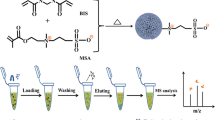Abstract
Affinity microspheres were prepared by immobilizing human γ-globulin (HγGb) onto carboxylated poly (styrene/acrylamide) latex particles [P(St/AAm)-H; average diameter 0.33 μm], which were prepared by emulsifier-free emulsion polymerization. HγGB was covalently immobilized onto the latex particles with high efficiency by the carbodiimide method. A fusion protein (ZZB1B2) of immunoglobulin G and albumin-binding domains (ZZ and B1B2, respectively) was expressed intracellularly and extracellularly in Escherichia coli and was purified by the affinity microspheres. In poly (ethylene glycol) (PEG)/potassium phosphate aqueous two-phase system, the affinity microspheres were partitioned into the PEG-rich top phase, while cells and cell debris of E. coli were displaced into the salt-rich bottom phase. Therefore, ZZB1B2 was directly purified from cell disintegrate or culture broth by combining the affinity microspheres with the aqueous two-phase partitioning, and its purity was almost the same as that purified by conventional affinity chromatography. Therefore, by this purification method, the primary purification process and the subsequent high resolution purification process are combined, and the number of purification steps can be reduced.
Similar content being viewed by others
References
Bonnerjea J, Oh S, Hoare M, Dunnill P (1986) Protien purification: the right step at the right time. Bio/Technology 4:954–958
Hammarberg B, Nygren P-Å, Holmgren E, Elmblad A, Tally M, Hellman U, Moks T, Uhlén M (1989) Dual affinity fusion approach and its use to express recombinant human insulin-like growth factor II. Proc Natl Acad Sci USA 86:4367–4371
Kondo A, Yamasaki R, Higashitani K (1992) Affinity purification of antibodies using immunomicrospheres. J Ferment Bioeng 74:226–229
Köhler K, Bonsdorff-Lindeberg L von, Enfors S-O (1989) Influence of disrupted biomass on the partitioning of β-galactosidase fused protein A. Enzyme Microb Technol 11:730–735
Lea T, Vartdal F, Nustad K, Funderud S, Berg A, Ellingsen T, Schmid R, Stenstad P, Ugelastad J (1988) Monosized magnetic polymer particles: their use in separation of cells and subcellular components, and in the study of lymphocyte function in vitro. J Mol Recog 1:9–18
Ling TGI, Mattiasson B (1989) Membrane filtration affinity purification (MFAP) of dehydrogeneses using cibacron blue. Biotechnol Bioeng 34:1321–1325
Mattiasson B, Ling TGI (1986) Efforts to integrate affinity interactions with conventional separation technologies. Affinity partition using biospecific chromatographic particles in aqueous two-phase systems. J Chromatogr 376:235–243
Nygren P-Å, Eliasson M, Abrahamsén L, Uhlén M, Palmcrantz E (1988) Analysis and use of the serum albumin binding domains of streptococcal protein G. J Mol Recog 1:69–74
Rüther U (1982) pUR250 allows rapid chemical sequencing of both DNA strands of its insert. Nucleic Acids Res 10:5765–5772
Stanley KK (1990) The pEX vectors and their uses in molecular and cell biology. In: Alitalo KK, Huhtala M-L, Knowles J, Vaheri A (eds) Recombinant systems in protein expression. Elsevier, Amsterdam, p 3
Tamai H, Fujii A, Suzawa T (1987) Some colloidal considerations on the surface concentrations of various emulsifier-free polymer latices. J Colloid Interface Sci 116:37–41
Ugelstad J, Berge A, Ellingsen T, Bjorgum J, Schmid R, Stenstad P, Aune O, Nilsen TN (1987) Biomedical applications of monodisperse magnetic polymer particles In: El-Asser MS, Fitch RM (eds) Future directions in polymer colloids. Nijhoff, Dordrecht, pp 355–370
Uhlén M, Moks T (1990) Gene fusion for purpose of expression: an introduction. Methods Enzymol 185:129–143
Veide A, Lindback T, Enfors S-O (1984) Continuous extraction of β-d-galactosidase from Escherichia coli in an aqueous two-phase system: effects of biomass concentration on partitioning and mass transfer. Enzyme Microb Technol 6:325–330
Veide A, Strandberg L, Enfors S-O (1987) Extraction of β-galactosidase fused protein A in aqueous two-phase systems. Enzyme Microb Technol 9:730–738
Author information
Authors and Affiliations
Additional information
Correspondence to: A. Kondo
Rights and permissions
About this article
Cite this article
Kondo, A., Kaneko, T. & Higashitani, K. Purification of fusion proteins using affinity microspheres in aqueous two-phase systems. Appl Microbiol Biotechnol 40, 365–369 (1993). https://doi.org/10.1007/BF00170394
Received:
Accepted:
Issue Date:
DOI: https://doi.org/10.1007/BF00170394




